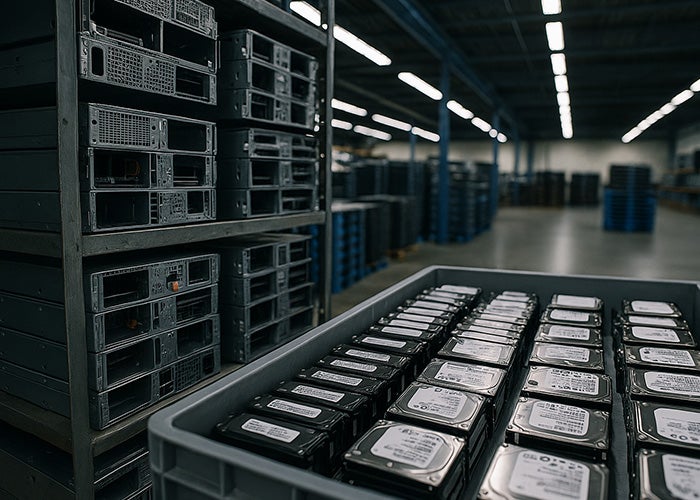Steigende Nachfrage nach End-to-End-Lebenszyklusservices von der Beschaffung bis zur Kreislaufwirtschaft
Rechenzentrumsbetreiber stehen vor immer komplexeren, sich ständig weiterentwickelnden Lieferkette, Technologie und regulatorische Rahmenbedingungen. Jeder Betreiber hat seine eigene Perspektive und Strategie für die Entwicklung, Beschaffung, Herstellung, Bereitstellung und Verwaltung seiner Produkte über den gesamten Produktlebenszyklus hinweg. Dies kann interne Produkte wie kundenspezifische Prozessoren und neue, über die Infrastruktur bereitgestellte Cloud-Instanzen umfassen. Unabhängig davon, ob sich ein Unternehmen für Insourcing oder Outsourcing entscheidet, ist Flexibilität ein wichtiger Faktor bei der Einbindung des Ökosystems in jeder Phase des Produktlebenszyklus.
Flexability im Design ist entscheidend. Einige Unternehmen legen Wert auf individuelle Anpassung, während andere Referenzdesigns von Industriestandards verwenden, wie z. B. Offenes Rack v3 Spezifikationen wie beispielsweise dem Open Compute Project (OCP) oder nehmen Sie leichte Anpassungen an diesen Designs vor.
Dieses Beispiel unterstreicht den Wert regionalisierter Fertigungsökosysteme für Unternehmen, die ihre Lieferketten flexibel und widerstandsfähig gestalten möchten. Die Nähe zu den Endmärkten stimmt die Produktion auf die Nachfragesignale ab und ermöglicht so maßgeschneiderte Produkte für lokale Bedürfnisse und Nachhaltigkeitsziele. Für Rechenzentrumsbetreiber stellt dies die pünktliche Lieferung von IT-, Strom- und Kühlinfrastruktur in der gewünschten Konfiguration sicher. Darüber hinaus erhöht die späte Positionierung von Systemen für stark nachgefragte Komponenten wie GPUs im Prozess die Flexibilität und Reaktionsfähigkeit in Umgebungen mit eingeschränktem Angebot.
Die Ansiedlung von Produktions- und Serviceeinrichtungen in der Nähe der Nachfrage reduziert Risiken und Komplexitäten im Zusammenhang mit Handelsvorschriften, Zöllen, geopolitischen Veränderungen und Lieferkettenunterbrechungen. Beispielsweise umfasst die vertikale Integration von Rechenzentrums-Racks die Blechbearbeitung, die Rack-Montage und die Prüfung von Rechen-, Speicher-, Netzwerk-, Stromversorgungs- und Flüssigkeitskühlungskapazitäten an einem Standort. Ohne vertikale Integration würden der Gesamtaufwand und die Kosten (einschließlich Zölle) für die Verpackung und den Versand jeder dieser Schlüsselkomponenten an die Rechenzentren den Kosten des Racks selbst entsprechen oder diese übersteigen. Zudem würden pro Rack zusätzliche 90 Kilogramm Verpackungsmüll entstehen.
Nutzen Sie Analytik, KI und Visualisierung über den gesamten Lebenszyklus hinweg
Bei Flex verbinden wir Flexibilität, Präzision und Kontrolle durch Daten, Analysen, KI und Automatisierung. IT-Experten verstehen, wie diese Intelligenz im Servermanagement für vorausschauende Wartung, Problemlösung, Ressourcenzuweisung, Lastverteilung und Energieoptimierung eingesetzt werden kann. Ähnliche Vorteile ergeben sich auch in der Lieferkette.
Integration des Produktlebenszyklus zur Bewältigung der Herausforderungen moderner Rechenzentren
Hyperscaler stehen vor besonderen Herausforderungen bei der Modernisierung und dem Neubau von Rechenzentren, um ihren Wettbewerbsvorteil zu sichern. Zu diesen Herausforderungen zählen die schnelle Produktentwicklung für kundenspezifische Systeme und die hohe Nachfrage in verschiedenen Regionen. Wir sind überzeugt, dass die Integration fortschrittlicher Fertigungs-, Stromversorgungs- und Kühllösungen mit Lifecycle-Services ein optimales Gleichgewicht zwischen Kontrolle und Optimierung schafft.
Dank der Expertise von Flex analysieren wir Infrastrukturen in den Bereichen Computing, Speicher, Netzwerk, Stromversorgung und Kühlung und entwickeln Lösungen, die Kosten, Belastbarkeit und Umweltverträglichkeit in Einklang bringen. Durch die Integration von Design, Beschaffung, Herstellung, Lieferung und Wartung können Hyperscaler Reibungsverluste reduzieren, die Lieferung beschleunigen und Investitionen maximieren.







